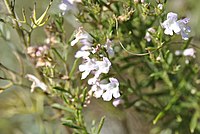
Photo from wikipedia
Sclerotinia sclerotiorum is a devastating plant pathogen that causes substantial losses in various agricultural crops. Although plants have developed some well-known defense mechanisms against invasive fungi, much remains to be… Click to show full abstract
Sclerotinia sclerotiorum is a devastating plant pathogen that causes substantial losses in various agricultural crops. Although plants have developed some well-known defense mechanisms against invasive fungi, much remains to be learned about plant responses to fungal pathogens. In this study we investigated how plant primary and secondary metabolism in the model plant Arabidopsis thaliana are affected by S. sclerotiorum infection. Our results showed that the contents of soluble sugars and amino acids changed significantly in A. thaliana leaves upon fungal colonization, with a decrease in sucrose and an increase in mannitol, attributed to fungal biosynthesis. Furthermore, the jasmonate signaling pathway was rapidly activated by S. sclerotiorum infection, and there was a striking accumulation of antifungal metabolites, such as camalexin, p-coumaroyl agmatine, feruloyl agmatine, and Nδ-acetylornithine. On the other hand, the characteristic defense compounds of the Brassicaceae, the glucosinolates, were not induced in A. thaliana infected by the fungus. Our study provides a better understanding of how A. thaliana primary and secondary metabolism are modified during infection by a fungal pathogen like S. sclerotiorum that has both hemibiotrophic and necrotrophic stages.
Journal Title: Phytopathology
Year Published: 2020
Link to full text (if available)
Share on Social Media: Sign Up to like & get
recommendations!